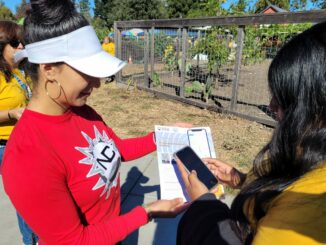
Long Beach’s Community Emergency Response Team (CERT) trains volunteers to step up when disaster hits
by M.S. Enkoji
A 6.4 earthquake shook Long Beach in 1933, killing at least 120 people who were mostly crushed in inadequate masonry buildings. Building standards changed immediately throughout the Los Angeles Basin to save lives, but the risk of deadly quakes will always threaten the harbor city perched on man-made land.
Unlike in the 1930s, Long Beach now has the Community Emergency Response Team (CERT), a network of volunteers with vital knowledge and training to help themselves and their neighbors during disasters.
“Volunteers are the first to arrive in many instances,” says Jacob Heflin, battalion chief with the Long Beach Fire Department. Heflin also leads up CERT through the Friends of the Long Beach Firefighters. CERT volunteers respond to disasters in their own neighborhoods, as first responders are often stretched thin during massive disasters—like fires or destructive earthquakes—in urban areas. The more volunteers can help, the more emergency personnel can focus on more skilled tasks.
“It’s doing the greatest good for the greatest amount of people in the shortest amount of time.”
Jacob Heflin, Long Beach Fire Department Battalion Chief and Community Emergency Response Team (CERT) Program Manager
“We realize as firefighters that when a large-scale disaster occurs, we have to leverage those resources where we can do the greatest good,” Heflin says. “It’s going to take time for additional resources to get into our community.”
CERT started with the Los Angeles City Fire Department in 1985 and has grown to establish teams in all 50 states, some territories and tribal nations, and is coordinated through the Federal Emergency Management Agency.
There are more than 450 CERT programs in California, which also work in conjunction with the California Governor’s Office of Emergency Services (Cal OES).
In Long Beach, volunteers sign up for 21 hours of training, which includes a simulated disaster at the end to test their skills. Besides basic first aid, volunteers learn skills such as how to assess whether a building has suffered light or heavy damage before trying to enter it, how to form search patterns and how to turn off gas lines. Medical training includes treating heavy bleeding, shock, hyperthermia, and how to triage.
Volunteer training focuses on disasters most likely to occur in their region. Long Beach, built on miles of pipelines and reshaped by waterlogged silt to carve out the Los Angeles Harbor, is susceptible to earthquake disasters. Spreading the word about how to protect oneself – “Drop, Cover, and Hold On” – is vital in this community. Resulting tsunamis and fires are also possibilities they are trained to face.
Volunteers learn how to form effective command structures. They even delve into disaster psychology, such as how to express sympathy and what to say or what not to say to victims in distress.
“It’s doing the greatest good for the greatest amount of people in the shortest amount of time,” says Heflin, a 25-year-veteran of the department.
About 2,000 volunteers are on the Long Beach CERT newsletter list. There are about 500 on the waiting list. The community is eager for the training, Heflin says, because people realize the possibility of what can happen and the limitation of emergency services in a disaster. Participants are all ages and come from all backgrounds.
CERT also sends out teams beyond their neighborhoods. They have filled sandbags for storms and knocked on doors to inform residents of impending disasters. During the disastrous wildfires in Los Angeles County in January 2025, Long Beach CERT volunteered in the Pacific Palisades neighborhood in Los Angeles, where team members distributed protective equipment to residents as they were allowed to return to their homes after the fire.
One important thing people can do without formal training, Heflin says, is to get to know their neighbors: There’s power in community. Mine all know I’m a firefighter. Neighbors are often the first ones on the scene during a disaster, knowing them ahead of time can make you that much safer.
For more information about Long Beach’s Community Emergency Response Team (CERT), visit www.longbeach.gov/fire/community-outreach/cert/. To learn more about the Friends of Long Beach Firefighters, go to www.friendsoflbfire.org.
Drop, Cover and Hold On
- Identify movable hazards like mirrors, bookshelves, water heaters and refrigerators
- Secure them with straps, hooks or latches
- Keep heavy or large items away from escape routes, beds and couches
- Drop where you are to your hands and knees
- Cover your head and neck and crawl to a protected space or interior wall
- If outside, stay in open spaces and away from buildings, power lines and trees
- Hold on until the shaking stops
For more information on how to prepare for and stay safe during and after earthquakes and other emergencies, visit www.listoscalifornia.org.




